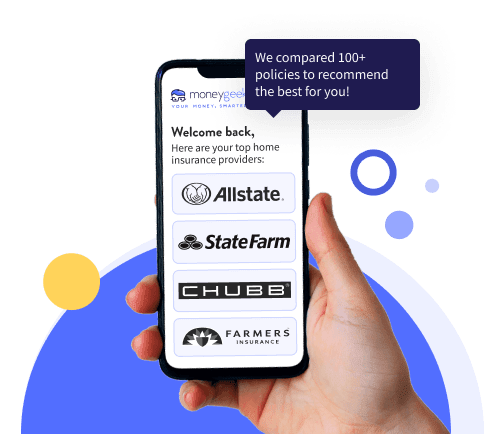You can change homeowners insurance at any time, even in the middle of your policy term. However, some insurers may charge a cancellation fee if you end your policy early. Since insurance regulations and coverage options vary by state, always check your current policy's terms to understand any penalties or refund options.
How to Switch Home Insurance Companies
You can switch home insurance companies anytime by comparing quotes, securing a new policy and canceling your current one without a coverage gap.
Find out if you're overpaying for homeowners insurance below.

Updated: November 7, 2025
Advertising & Editorial Disclosure
You can change homeowners insurance anytime; no need to wait for your current policy to expire.
To switch providers, gather and compare quotes from different insurers, secure a new policy and then cancel your old one. If applicable, inform your mortgage lender about the change.
When switching providers, timing matters. You might miss better deals or discount programs, risk a coverage gap or pay for two policies simultaneously.
Can You Change Homeowners Insurance at Any Time?
Can You Switch Homeowners Insurance If You Have An Escrow Account?
An escrow account doesn’t stop you from changing insurance companies. The account simply holds part of your monthly mortgage payment so your lender can pay property taxes and insurance premiums on your behalf.
When you switch, your new insurer sends proof of coverage to your lender, who updates the escrow account to direct payments correctly. If you’ve prepaid your old policy, you’ll usually get a prorated refund. Just be sure your lender and new insurer have the right mortgage details to keep coverage seamless.
How to Switch Home Insurance Providers in 5 Steps
Switching homeowners insurance is as simple as buying a new policy and canceling the old one. However, follow some key steps to ensure you purchase adequate coverage, avoid coverage lapses and don't end up paying for two policies at once.
Learn how to change homeowners insurance companies, even in the middle of your policy term:
1. Review Your Coverage and Decide If a Switch Is Right for You
Knowing your policy details, like your limits and deductibles, helps you make informed decisions when changing providers. Taking time to review what your home insurance covers prevents purchasing a plan with unnecessary or missing coverage.
Key details to know before searching for a new provider include:
- Coverage limits
- Deductible amount
- Inclusions and exclusions
- Renewal date
- Any lender-required coverages, such as flood or earthquake insurance
Weigh the pros and cons before making a change. Switching could lower your premiums, improve your coverage or give you access to better customer service, but it might also come with cancellation fees or the loss of loyalty discounts. If your current policy offers sufficient protection at a competitive price, staying with your provider may be the better choice.
You can switch home insurance policies as often as you'd like, but be wary of cancellation fees. It may be best to stay with a provider that offers strong coverage at a fair price because the cheapest option isn’t always the best and coverage standards can vary by company. Many insurers also reward loyal customers with discounts or other benefits over time.
2. Gather Details and Compare Quotes From Several Providers
Shopping around is one of the most effective ways to find the best home insurance company at the best price. Start by collecting all the personal and property details insurers will need for an accurate quote, then request estimates from at least three to four companies. You can shop online and use an online comparison tool to save time and look at sample rates from multiple insurers simultaneously.
Here's what to compare when reviewing homeowners insurance quotes:
Review the dwelling, personal property and liability limits to ensure they’re high enough to cover potential losses. Inadequate limits could leave you paying huge costs out of pocket, so check whether the new policy matches or improves upon your current coverage.
Compare deductible amounts, which is what you'll pay out-of-pocket before your insurance coverage kicks in for covered claims. A higher deductible usually lowers your premium, but make sure it’s an amount you could comfortably afford after a loss and see if it’s better or worse than your current deductible.
Check which risks are included and what’s excluded because policies vary between providers. Compare these to your existing policy to ensure you’re not losing essential protections.
See if the policy offers add-ons like flood, earthquake or scheduled personal property coverage. Determine whether these options fill gaps left by your current policy or provide better value.
Ask about discounts for bundling, home security systems or a claims-free history. Compare these to what your current insurer offers to see if switching would give you more affordable home insurance.
Research how quickly and fairly the insurer handles claims. Look at reviews and ratings, then weigh them against your own experience with your current provider.
Choose a company with strong financial health to ensure it can pay out claims, even after disasters.
Personal information:
- Birth date
- Address
- Social Security number
Home information:
- Construction date
- Used materials
- Square footage
- Renovations or repairs made on your home
- Security devices installed
Other relevant information:
- How many people live in your home
- Your claims history
- Your credit standing
- Dogs or other pets
3. Choose Your New Policy and Match Start and End Dates
After reviewing your options, choose the policy that offers the right mix of cost, coverage and service for your needs. This decision often comes down to how much value you’re getting for the price, so it’s worth seeing how different insurers compare at the same coverage level. The table below shows how the average cost of home insurance changes by company and coverage level.
| State Farm | $1,026 |
| Nationwide | $1,236 |
| Farmers | $1,242 |
| Allstate | $1,449 |
| Travelers | $3,674 |
Pay attention to the effective date so your new coverage starts before, or on the same day, your old policy ends to prevent a lapse. Aligning these dates also helps you avoid paying for overlapping coverage, ensuring a smooth and cost-effective transition.
When narrowing down homeowners insurance options, look beyond rates. Consider each policy's billing plan, deductible and effective date. Reading homeowners insurance reviews can also provide valuable insight into what different companies offer.
4. Cancel Your Old Policy
Before canceling your current homeowners insurance, notify your provider in advance. If your policy auto-renews, confirm the cancellation date and ask if you need to provide written notice. Get the correct contact information and include all necessary details to avoid delays or extra charges.
You can switch insurance anytime, but don't cancel your current policy before the new one takes effect. This prevents coverage gaps and paying for overlapping policies. For homeowners with a mortgage, a coverage lapse could violate your loan agreement and put your home at risk.
When you switch home insurance mid-term, your old provider usually issues a prorated refund for the unused portion of your premium. Depending on your policy, you may pay a small cancellation fee, but most refunds are sent by check or direct deposit once your cancellation is processed.
5. Let Your Lender Know About the Change
Your mortgage usually requires up-to-date home insurance. Call your lender and tell them you've changed insurance companies.
Send them documentation that includes:
- Your mortgage loan number
- Names and addresses of your present and new insurance companies
- Your old and new policy numbers
- Payment receipt from your new insurance company
- Copy of your previous policy’s cancellation notice
If you don't maintain insurance coverage, your lender can default on your mortgage, which could lead to home foreclosure. Telling them about your insurance change ensures your records stay updated and protects your loan.
Switching Home Insurance: When to Do It
Changing home insurance companies is within your rights as a homeowner. Switching providers can give you more control over your insurance, and you can do it anytime.
Here are some of the most common reasons homeowners consider changing home insurance providers:
Switch if you find a lower premium, especially after rate hikes or a claim. Some insurers even offer discounts to attract new customers.
Reassess your coverage needs when your life circumstances change, like getting married, starting renovations or acquring new valuables. Another provider may offer better options for add-ons like flood or earthquake coverage.
Move on if your insurer handles claims poorly or causes extra stress. The best home insurance companies offer strong customer service and financial stability, which can make future claims easier.
Switch to take advantage of bundling your home and auto policies or unlocking new discounts. Comparing providers can help you save more without losing essential coverage.
Review your homeowners insurance at least once a year, especially when your policy comes up for renewal. Annual check-ins let you see if your coverage still matches your needs and whether you’re paying a fair price. Even if you don’t switch providers, comparing quotes regularly helps you stay prepared to make a change when the time is right.
Switching Homeowners Insurance: Bottom Line
Learning how to switch home insurance companies can help you save money, improve your coverage or get better customer service. You don’t have to wait until your policy expires because switching can be done anytime with the right steps. Avoid coverage gaps by securing your new policy before canceling the old one, and choose a provider that better fits your needs.
Ensure you're getting the best rate for your home insurance. Compare quotes from the top insurance companies.
Changing Homeowners Insurance Companies: FAQ
Homeowners considering changing insurance companies often have questions about the process. Here are answers to help make switching providers easier.
When should I change home insurance companies?
To know when to change home insurance companies, ensure your timing is right when changing companies to avoid paying for two policies or having a coverage gap, which could affect your mortgage. Learn about any fines and penalties for not finishing your policy term. Review your policy or speak directly with your insurer to determine specific amounts.
How often should I change home insurance companies?
To determine how often to change home insurance companies, consider that life events (such as getting married or renovating your house) change how much coverage you need. These events might mean it's time to look for a new policy. Shop around for homeowners insurance yearly. Rates can change yearly, so checking competitors annually might help you find lower premiums for similar coverage.
How do I know if switching home insurance companies is a good idea?
To know if switching home insurance companies is a good idea, compare the new policy's features to your current coverage. Look for home insurance providers with lower rates; changing can be a sound decision if they provide the same coverage. Reconsider if a lower rate means losing important features.
Can you switch home insurance mid-policy?
You can switch home insurance companies mid-policy at any time you like. However, you may have to pay a fee if you cancel your policy before it expires.
Do I get a refund if I cancel my home insurance early?
If you cancel your home insurance early, refund eligibility varies by provider. Some offer refunds for unused months if you pay annually (minus cancellation fees). If you pay in installments, insurers won't return payments you've already made. Refund eligibility depends on the terms in your policy.
How to Switch Home Insurance: Our Review Methodology
We analyzed quotes from multiple insurance providers across the U.S. using a profile of an average homeowner. By examining different locations and companies, we provide reliable estimates of what homeowners usually pay, showing why comparing rates is important.
Homeowner Profile
For our analysis, we created a sample homeowner profile with the following characteristics:
- Good credit score (769 to –792)
- Home constructed in 2000
- Wood-frame construction
- Composite shingle roof
Homeowners Insurance Coverage Details
Unless otherwise specified, we used the following coverage limits to collect quotes for our comparison:
- $250,000 in dwelling coverage
- $125,000 in personal property coverage
- $200,000 in personal liability coverage
- $1,000 deductible
We also compiled data for policies with broader coverage to determine the best companies for insuring expensive homes, upping limits to $1 million in dwelling coverage, $500,000 in personal property coverage and $1 million in liability coverage.
Can You Change Home Insurance Anytime: Related Articles
About Mark Fitzpatrick

Mark Fitzpatrick, a Licensed Property and Casualty Insurance Producer, is MoneyGeek's resident Personal Finance Expert. With over five years of experience analyzing the insurance market, he conducts original research and creates tailored content for all types of buyers. His insights have been featured in publications like CNBC, NBC News and Mashable.
Fitzpatrick holds a master’s degree in economics and international relations from Johns Hopkins University and a bachelor’s degree from Boston College. He's also a five-time Jeopardy champion!
He writes about economics and insurance, breaking down complex topics so people know what they're buying.
sources
- Insurance Information Institute. "10 Questions to Help Assess Your Changing Insurance Needs." Accessed May 14, 2025.





